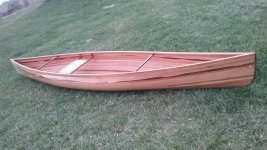My last strip build was intended as a sort of all-around canoe for the sort of things that I expected to do, both solo and tandem. During the design discussion I was told by a couple of people that I would probably be happier with two boats - a solo, and a tandem. After a summer with "The Experiment" I can say that they were right.
My tandem is just too big for one smallish guy (<150#) to handle as a day-tripper. The things that I've run into on daytrips with no/light load are as follows:
1-3 settle down considerably when I add another person, and I imagine that with a couple of weeks worth of gear, she'd be fairly comfortable as a tripping solo. As a Tandem, I'm fairly happy with her. However, I don't want to carry 200# of ballast just to do a short day-paddle, which accounts for most of my paddling time.
There are a few things that do like, though:
Given all of this, I'd like to build a dedicated solo something like this:
I'm also sorely tempted to go to the dark side, and build <a kayak>, (Nick Schade has some lovely boats that are just begging to be built) But I figured I should see what's available in the open-boat world before committing.
My tandem is just too big for one smallish guy (<150#) to handle as a day-tripper. The things that I've run into on daytrips with no/light load are as follows:
- Directional stability: She likes to turn. Doesn't seem to matter which direction, what type of paddle stroke, etc.
- Windage: Not nearly as bad as my first canoe, but any sort of starting-to-be-stiff-ish breeze will send her skittering
- Trim: as much as I've tried, I've not been able to get comfortable sitting center in a hull sized as a tandem. It's certainly doable, but not great. I've been running with the hull reversed, from the front seat, but in that position, I need a 50# bag of ballast along.
- Hull efficiency: perhaps more subjective, but this hull seems to gain a lot of resistance if I ever try to do a short sprint, and the wake it leaves seems more turbulent than my previous hulls
1-3 settle down considerably when I add another person, and I imagine that with a couple of weeks worth of gear, she'd be fairly comfortable as a tripping solo. As a Tandem, I'm fairly happy with her. However, I don't want to carry 200# of ballast just to do a short day-paddle, which accounts for most of my paddling time.
There are a few things that do like, though:
- Good balance in roll-direction stability. The flared hull shape lets me stand in the unloaded canoe, and I could paddle it SUP style if I wanted to.
- Conversely, It takes very little effort to quickly roll all the way to a gunwale, if desired, but removing your lean will bring it right back up.
- Pick a heel angle, any heel angle, and settle in to paddle.
- Knuckled tumblehome allows me to have the flared shape for the wetted hull, but eases reach for paddling nearer center.
Given all of this, I'd like to build a dedicated solo something like this:
- 150# paddler plus day gear or a very light weekend kit.
- Good tracking, I'm comfortable heeling over when I want to turn hard...
- Balanced with a soft enough forefoot that it can handle some chop or riffles without stubbing its toe.
- Lower profile to reduce windage. I'd rarely, if ever, be out on big water. I'd be willing to consider a canvas spray cover for the times when I would be.
- Paddler's station narrow enough to use a double blade easily.
- Shallow draft
I'm also sorely tempted to go to the dark side, and build <a kayak>, (Nick Schade has some lovely boats that are just begging to be built) But I figured I should see what's available in the open-boat world before committing.
Last edited:

